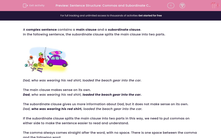A complex sentence contains a main clause and a subordinate clause.
In the following sentence, the subordinate clause splits the main clause into two parts.

Dad, who was wearing his red shirt, loaded the beach gear into the car.
The main clause makes sense on its own.
Dad, who was wearing his red shirt, loaded the beach gear into the car.
The subordinate clause gives us more information about Dad, but it does not make sense on its own.
Dad, who was wearing his red shirt, loaded the beach gear into the car.
If the subordinate clause splits the main clause into two parts in this way, we need to put commas on either side to make the sentence easier to read and understand.
The comma always comes straight after the word, with no space. There is one space between the comma and the following word.








